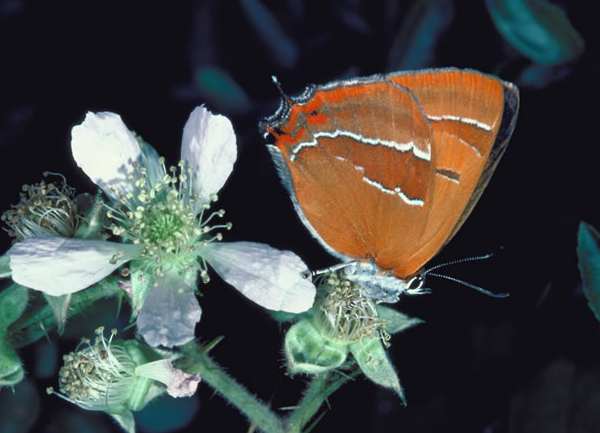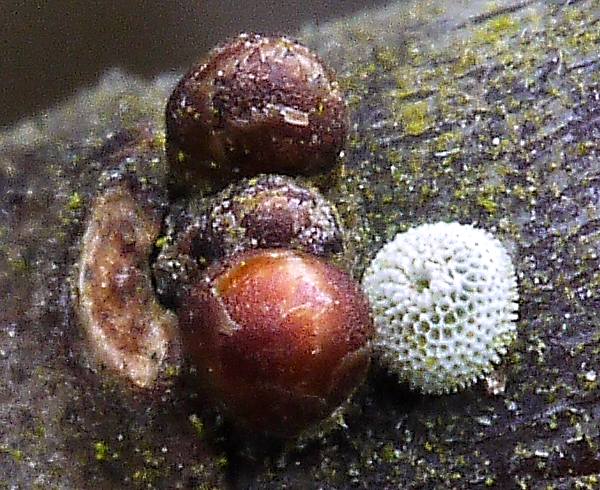Brown Hairstreak Butterfly - Thecla betulae
Phylum: Arthropoda - Class: Insecta - Order: Lepidoptera - Family: Lycaenidae

The Brown Hairstreak is the largest of the hairstreak butterflies found in Britain. As with other butterflies in this group, it usually holds its wings closed when at rest.
Description
With a wingspan of 38 - 40mm, the males being slightly smaller than the females, Brown Hairstreaks are medium-sized butterflies, but they are scarce and can be very hard to find. Seen in flight from underneath or with wings closed when at rest, they are very beautiful; this comment applies particularly to the females which are even more brightly coloured than the males. The upperwings are brown, and in females they contain large orange splashes on the forewings, while males have much smaller pale forewing spots.
Distribution
Very much a southern species in Britain, this butterfly is rare and localised in southern England and in west Wales, while in Ireland its main strongholds are in the Burren, County Clare, and in the south-east of County Galway. This species is also found in many parts of mainland Europe and Asia.
Lifecycle
Spending much of the time in the tops of tall Ash trees, Fraxinus excelsior - now, of course, being felled in great numbers due to Ash Dieback Disease - adult Brown Hairstreaks are also seen along woodland edges and dense hedgerows, particularly those containing Blackthorn Prunus spinosa. The adults also take nectar from various kinds of wildflowers including Brambles Rubus fructicosus, Common Ragwort Senecio jacobaea, and Hemp Agrimony Eupatorium cannabinum.
The main larval foodplant of the Brown Hairstreak is Blackthorn. The amazingly intricate eggs are laid in late August and hatch the following April.

The green, slightly hairy caterpillars are plump and have rows of short diagonal whitish dashes along the sides. They feed at night, resting on the undersides of blackthorn leaves during the daytime.
When fully grown the larvae pupate among the dead twigs and leaf litter beneath Blackthorn bushes. The adult butterflies emerge from early August.
Acknowledgements
This page includes pictures kindly contributed by Betty and Tony Rackham and by the Countryside Council for Wales.
Studying butterflies and moths...
Excited by rivers and streams? So are we, and we're pretty sure you would find the Winding River Mystery trilogy of action-packed thrillers gripping reading too. Dead Drift, Dead Cert, and Dead End are Pat O'Reilly's latest river-based novels, and now they are available in ebook format. Full details on our website here...
Buy each volume in ebook format for only £2.47 on Amazon... Paperbacks also available on Amazon at £6.95 each. All proceeds go towards keeping the First Nature website online.
Please Help Us: If you have found this information interesting and useful, please consider helping to keep First Nature online by making a small donation towards the web hosting and internet costs.
Any donations over and above the essential running costs will help support the conservation work of Plantlife, the Rivers Trust and charitable botanic gardens - as do author royalties and publisher proceeds from books by Pat and Sue.
